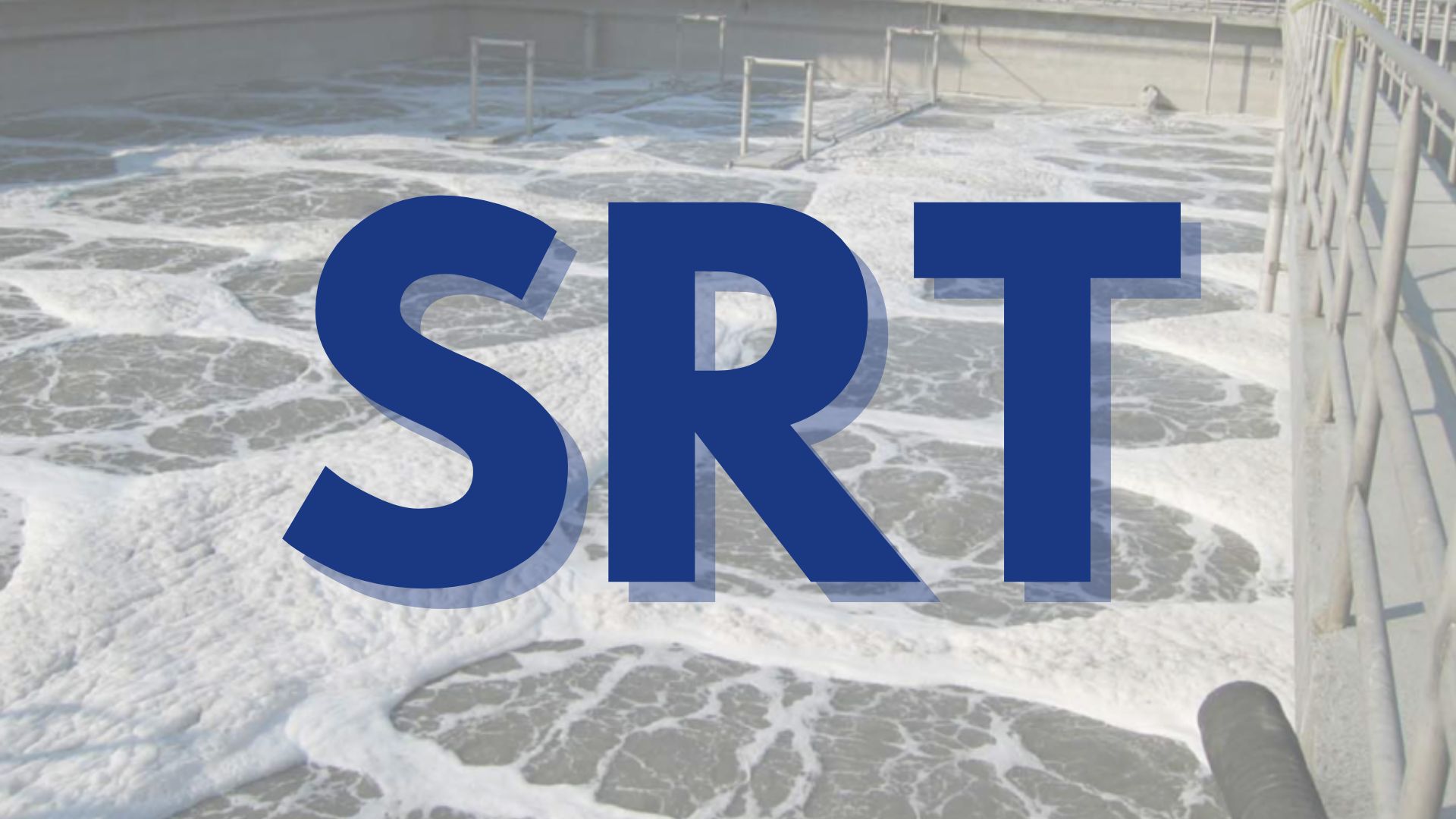How to Fine-Tune Your Solids Retention Time

Solids Retention Time (SRT) is a fundamental metric in the operation of a wastewater treatment plant. In short, SRT is the average length of time that the activated sludge remains in the biological treatment system, and plays a crucial role in managing sludge, suspended solids, and overall treatment performance.
Understanding your SRT is critical because this metric influences the overall performance of the biological treatment process. SRT affects the reduction of organic pollutants, nutrient removal, sludge production, and the stability of the microbial community within the system. Proper SRT control creates optimal treatment performance and contributes to better management of dissolved solids and organic compounds.
Your team can adjust solids retention time to better manage wastewater treatment efforts, whether you operate a municipal wastewater facility, residential and commercial development, hotel, casino, or an industrial wastewater treatment system.
The Role of SRT in Biological Treatment
SRT, often referred to as “sludge age,” is integral to the control of microbial population dynamics in a wastewater treatment plant. It determines the balance between microbial growth and decay, directly influencing the decomposition of organic matter and the breakdown of volatile solids.
An optimal SRT helps in maintaining a robust and healthy microbial community, which in turn sets up efficient biological treatment and compliance with discharge standards. It also influences the rate of sludge digestion and the solids concentration within the system.
A longer SRT allows for more complete digestion of organic compounds, while a shorter SRT may lead to insufficient treatment and higher effluent organic loads. The optimal point between these extremes—often referred to as high SRT or low SRT—will depend on your specific application.
The duration of SRT directly influences the processes of nitrification and denitrification, both critical for pollutant removal and nitrogen management in wastewater. Properly managed SRT ensures that nitrifiers and denitrifiers have sufficient time to convert ammonium to nitrate and then to nitrogen gas, respectively.
Unlike traditional activated sludge processes, membrane bioreactor (MBR) systems decouple Hydraulic Retention Time (HRT) and SRT, allowing for longer SRTs without the risk of washout. This leads to enhanced biomass retention and stability, significantly improving the system’s ability to manage sludge age, and downstream sludge thickening.
A well designed bioreactor provides sufficient retention time and controlled aeration. The bioreactor operates with an extended SRT, ranging from 12+ days to 30+ days for enhanced nutrient removal, leading to a high concentration of active biomass capable of efficiently processing biodegradable organics, including BOD and COD. In such a system, digestion of complex organic material and improved sludge handling are often observed.
This extended SRT fosters a diverse microbial community with specialized niches. With the right microbials, the bioreactor will comprehensively degrade organic matter and nitrification. The aerobic conditions maintained in the bioreactor—such as in an aeration basin or aeration tank—promote the spread of nitrifying bacteria that are responsible for converting ammonium to nitrate. This ensures compliance with nitrogen effluent standards.
SRT is one space where the MBR design really excels, particularly in terms of supporting optimal SRT and reducing sludge production.
Factors Influencing SRT Optimization
Optimizing SRT requires consideration of various plant-specific and environmental factors:
Wastewater Composition: The nature of the incoming wastewater, including its organic strength and variability, dictates the necessary SRT to effectively handle the load. What sort of wastewater are you treating? Facilities processing dairy, brewery waste, or high-sugar content foods typically deal with high biological oxygen demand (BOD), volatile solids, and fluctuating loads. They require a carefully managed SRT to ensure complete organic breakdown without overloading the system. Domestic wastewater, for another example, generally has a consistent organic load, allowing for a more stable SRT that balances microbial life and effluent quality effectively.
Operational Conditions: Temperature and pH are among the environmental factors that significantly affect microbial activity and SRT. For instance, lower temperatures may slow biological reactions, necessitating a longer SRT to achieve similar levels of treatment observed at higher temperatures.
Plant Design and Configuration: The design of the treatment plant, including reactor type and configuration, influences how SRT can be manipulated and controlled. Aeration methods, digester volume, and the use of return activated sludge (RAS) lines all play a role in maintaining the appropriate sludge age.
Techniques for SRT Adjustment
Adjusting SRT is a dynamic process that involves various operational strategies to ensure optimal treatment efficacy. Advanced automation and control systems can help adjust SRT in real-time based on changes in influent characteristics and treatment performance metrics.
Managing Sludge Removal Rate
Sludge age, defined by the SRT, determines the maturity of the microbial community. Older sludge typically has a more established, diverse microbial population, which is key for efficient degradation of complex pollutants. However, overly aged sludge can lead to reduced metabolic activity, impacting the system’s efficiency.
Adjusting the sludge removal rate helps maintain an optimal microbial lifecycle, ensuring effective pollutant breakdown while avoiding the pitfalls of an aged sludge population.
The rate at which sludge is wasted (removed from the system) should match the growth rate of the biomass to maintain a constant SRT. If sludge is removed too quickly, it can lead to a young microbial community with insufficient time to stabilize and treat the wastewater effectively. Conversely, slow removal rates may result in a high concentration of old biomass. This can deteriorate the system’s performance due to endogenous decay, where microorganisms consume themselves in the absence of sufficient food supply.
Operators must consider factors such as hydraulic and organic loading rates, which can vary daily. Seasonal changes can also influence the characteristics of the influent, requiring adjustments in the sludge wasting schedule to maintain optimal SRT and system performance.
Biomass Concentration Adjustment
Adjusting the mixed liquor suspended solids (MLSS) concentration is a key method for managing SRT. Higher MLSS levels typically correspond to longer SRTs because there is more biomass available to process the organic matter, enhancing degradation rates.
Conversely, lower MLSS may reduce the SRT, quickening the process but potentially reducing treatment efficacy, especially for high-strength wastes.
For instance, in a municipal wastewater treatment plant dealing with seasonal population increases, raising the MLSS concentration helps maintain a longer SRT, ensuring efficient breakdown of increased organic loads despite higher inflow rates. This helps stabilize treatment performance during peak usage periods.
Feed Rate Modulation
By varying the influent flow rate and its organic load, operators can fine-tune the SRT to better match the treatment needs of the incoming wastewater.
Reducing the feed rate extends the retention time, giving microorganisms more time to break down pollutants, which is particularly beneficial in facilities dealing with complex or variable waste streams.
A dairy processing plant may reduce its influent flow rate during periods of high milk processing to extend the SRT. This adjustment helps manage the higher organic loads typical of dairy effluent, allowing more time for microbial activity to adequately process the increased nutrients and organic matter.
Use of Return Activated Sludge (RAS) Ratios
Modifying the return activated sludge flow rates can alter the amount of biomass recirculated back into the bioreactor, affecting the overall SRT. This is important for systems experiencing high influent variability or those needing fine-tuning of biological processes.
In a treatment plant experiencing fluctuations in ammonia levels due to varying industrial discharges, increasing the RAS ratio can help maintain a stable microbial community capable of efficient nitrification, thus ensuring consistent nitrogen removal despite influent variability.
Chemical Enhancements
Occasionally, chemicals like flocculants are added to improve settleability and compaction of the biomass. This can indirectly influence SRT by affecting how quickly sludge is removed and settled.
In a scenario where a paper mill faces issues with slow settling sludge, introducing a cationic flocculant can improve sludge compaction, allowing for more efficient sludge removal and control over the SRT. (A cationic flocculant is a chemical agent that helps aggregate particles and causes them to form larger clusters, or flocs, which can then be more easily removed from the water. These flocculants carry a positive charge, which attracts negatively charged particles in the water, such as certain types of dirt, organic materials, or microorganisms.)
This adjustment helps maintain desired operational conditions without overloading the system with excess biomass.
Benefits of Effective SRT Management
Effective SRT management yields multiple operational and environmental benefits. Optimized SRT leads to enhanced stability of the biological process, allowing for more consistent compliance with effluent quality standards.
Proper SRT management can reduce the need for chemical additions and decrease sludge handling and disposal costs by minimizing excess sludge production.
But this process does not come without its challenges. For one, facilities must adapt SRT dynamically to accommodate fluctuations in influent quality and flow, which can impact microbial health and process efficiency.
Some plants, especially older ones, may have limited flexibility in adjusting SRT due to design and technological constraints. Upgrading control systems and process instrumentation can help overcome these limitations, enabling more precise and responsive SRT management.
Conclusion
By deepening the understanding of solids retention time and its pivotal role in wastewater treatment, operators can enhance both the efficacy and efficiency of biological treatment processes.
This exploration provides the foundational knowledge needed for advanced SRT control and serves as a stepping stone for further discussions on state-of-the-art strategies and technological innovations in the field of environmental engineering.
Want to learn more? Read some of our recent articles:
Sign up for the Integrated Water Services newsletter below. We share important perspectives and news on MBR wastewater treatment every two weeks.
Sign up for the
Integrated Water Services newsletter.
We share important perspectives and news on MBR wastewater treatment every two weeks.


